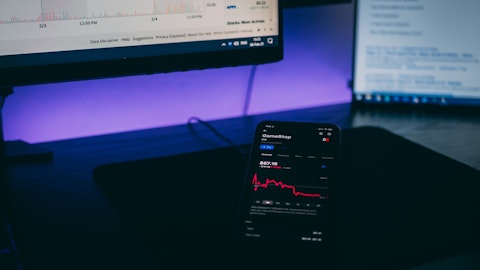Predictive Oncology Inc. (NASDAQ:POAI) Q3 2023 Earnings Call Transcript November 14, 2023
Operator: Good day, and thank you for standing by. Welcome to the Predictive Oncology Q3 2023 Earnings Conference Call. [Operator Instructions] Please be advised that today’s conference is being recorded. And I would now like to hand the conference over to your speaker for today, Mr. Glenn Garmont, Investor Relations. Mr. Garmont, please go ahead.
Glenn Garmont: Welcome, and thank you, everyone, for dialing into the Predictive Oncology third quarter 2023 earnings call. First, you’ll hear from our Chief Executive Officer and Chairman of the Board, Raymond Vennare; then our Chief Financial Officer, Josh Blacher, will review our financials; finally, Dr. Pamela Bush, our Chief Business Officer, will join Raymond and Josh to answer any questions that you may have. Certain matters discussed on this call contain forward-looking statements. These forward-looking statements reflect our current expectations and projections about future events and are subject to substantial risks, uncertainties and assumptions about our operations and the investments we make. All statements other than statements of historical facts included in the call regarding our strategy, future operations, future financial position, future revenue and financial performance, projected costs, prospects, plans and objectives of management are forward-looking statements.
The words anticipate, believe, estimate, expect, intend, may, plan, would, target and similar expressions are intended to identify forward-looking statements, although not all forward-looking statements contain these identifying words. Our actual future performance may materially differ from that contemplated by the forward-looking statements as a result of a variety of factors, including, among other things, factors discussed under the heading Risk Factors in our filings with the SEC. Except as expressly required by law, the company disclaims any intent or obligation to update these forward-looking statements. And now I would like to turn the call over to Raymond Vennare, Chief Executive Officer. Raymond?

Copyright: nexusplexus / 123RF Stock Photo
Raymond Vennare: Glenn, thank you very much, and good morning, everyone. In March of this year, we were very pleased to announce a research collaboration with Cancer Research Horizons, whereby we would utilize our AI drug discovery platform, our PEDAL platform, to evaluate several CRH preclinical glutaminase inhibitor drug compounds to determine which cancer types and patient populations are most likely to respond to treatment with these compounds. As a reminder, CRH is the innovative engine at the core of Cancer Research UK, the largest independent funder of cancer research in the world. CRH has a network of more than 4,000 cancer researchers, an annual research spend of more than $370 million, 11 drugs currently on the market and another 160 candidates in various stages of development.
Today, I am pleased to announce that we have provided CRH with the initial results of this research collaboration, which, as you might imagine, is a very significant milestone for our company, not only in terms of the results themselves, but because we were able to achieve these results in a matter of weeks. By prioritizing the development of the strongest candidates for the ideal tumor types based upon the output from PEDAL, CRH can save significant time and resources by pursuing only those projects that are most likely to succeed in the clinic. With our proprietary biobank of more than 150,000 tumor samples and CLIA-certified wet labs, we believe we can predict with a higher degree of accuracy than anyone else the probability of clinical success because we were able to introduce patients and tumor heterogeneity into the very earliest stages of drug development.
See also Diversified Stock Portfolio: 10 Sector ETFs and International ETFs to Buy and 15 Best U.S. Stocks to Buy Now Under $10.
Q&A Session
Follow Predictive Oncology Inc. (NASDAQ:POAI)
Follow Predictive Oncology Inc. (NASDAQ:POAI)
And we can support our predictions with actual in silico modeling and bench level experimentation. With our data in hand, CRH can now prioritize the development of these compounds and seek potential licensing deals with large pharmaceutical companies for further development. This is significant for two reasons. First, because we are now eligible for development and commercialization milestones in the event that a licensing deal is executed as well as potential sales royalties; and second, because we believe the success of this first campaign, which, as I said, was completed in several weeks, should pave the way for additional projects from CRH. It is difficult to overstate the significance of the external validation that our initial campaign with CRH provides.
And this relationship has had a very positive impact on our business development efforts elsewhere. I am pleased with our progress to date and believe we have created a solid foundation on which to drive future growth. The emergence of AI is fundamentally changing how drugs are discovered and subsequently developed. And we are at the forefront of this exciting and foundational transformation. It is well known and generally accepted that approximately 95% of drug candidates never received commercial approval. But with our unique capabilities, our partners can gain insight into the future of heterogeneous drug response and confidently make strategic clinical drug development decisions with lower financial risk and greater likelihood of commercial success.
Turning now to another significant development since our last quarterly update. We announced just last week that we have successfully completed a multiyear retrospective study with UPMC Magee-Women’s Hospital in Pittsburgh. The purpose of this study was to build multi-omic machine learning models that could predict overall short- and long-term survival in ovarian cancer. The study incorporated one of the largest sets of multi-omic data from 235 ovarian cancer patients derived from tumor samples obtained at the time of diagnosis or first surgical intervention. The study was designed to identify the key features that drive overall survival endpoints. And in fact, we have been able to deliver strong predictive models with high levels of accuracy.
These data will be presented at multiple national medical meetings in 2024. And we are considering future initiatives to both expand and further utilize these cohorts. The power of our technology is made obvious here because our multi-omic machine learning models have the potential to identify and define certain prognostic subgroups within ovarian cancer. High-grade serous carcinomas, for example, of the ovary make up most ovarian cancer cases and have the lowest survival rate. As far as next steps are concerned, there is certainly an opportunity to learn more about features that were identified as having prognostic importance for the model. This includes features that originate from our own digital pathology slides library. Ultimately, these models could support the tailoring of therapies to individual patients with the goal of positively affecting the overall survival of ovarian cancer patients and the development of invaluable clinical support tools.
Clearly, there’s an opportunity here to explore drug rescue or repurposing for the treatment of ovarian cancer and in the process of discovery and development, identify significant intellectual property that is specific to these predictive models and beneficial to an AI-driven decision support platform. I would like to take a moment now to review some other significant projects that are ongoing. As you may recall, in February of this year, Predictive Oncology and Cvergenx announced a partnership to develop the first-ever genomics-based approach to precision radiation therapy and drug discovery utilizing artificial intelligence. The objective of this collaboration was to leverage and maximize the combined power of Predictive Oncology’s expertise in artificial intelligence and Cvergenx proficiency in biomarker development for radiation therapy to identify novel radioprotector and radiosensitizer drugs.
Since then, we have evaluated, trained or developed models to predict changes in radiosensitivity for more than 3,000 different drug exposures using well-established gene expression databases. Based on results from our preliminary models, we have submitted a step one proposal to NASA to search for radioprotective drugs to safeguard astronauts from radiation during space flight. An SBIR proposal will also be submitted to the NIH to propose drugs to protect workers in the nuclear energy industry and the military from the effects of radiation and in the clinical setting to increase the radiation sensitivity of tumor tissue for those patients receiving radiation therapy. As we all know, Predictive Oncology’s two most valuable assets are the biobank more than 150,000 tumor samples and repository of drug response data, which are integral to our PEDAL drug discovery platform, both to evaluate and guide the design of experiments and models.
Most of our current projects utilize PEDAL to direct drug screening in silico in order to minimize the time and material spent on physical laboratory experiments. The collaboration between Predictive Oncology and Cvergenx is driving expansion of those data sets, which may be leveraged in several important ways with respect to commercialization: first, to screen individuals for radiation sensitivity or resistance to improve the therapeutic effect of radiotherapy; second, to screen for interactions between sensitive or resistant patient tumor samples and therapeutic compounds; and third, to identify, combine or develop novel or repurpose radioprotective or radiosensitizing drugs. Separately but simultaneously, we have successfully developed a novel formulation for a protein drug candidate for an international pharmaceutical company that enabled that company to proceed with their toxicology studies.
And in addition to existing contracts with biotech and biopharma companies, we are collaborating with FluGen on a next-generation vaccine related to respiratory disease for which a Phase IIb grant has already been submitted to the NIH. Most recently, we just returned from BIO-Europe, where we met with 40 different pharmaceutical companies over three days. Several of these companies have expressed interest in our formulation services and the purchase of our endotoxin product. In addition, three other companies expressed interest in purchasing our proprietary high throughput self-interaction chromatography platform, referred to as HFC, that enables rapid high-volume screening to determine the optimum solubility and stability conditions for new vaccines.




